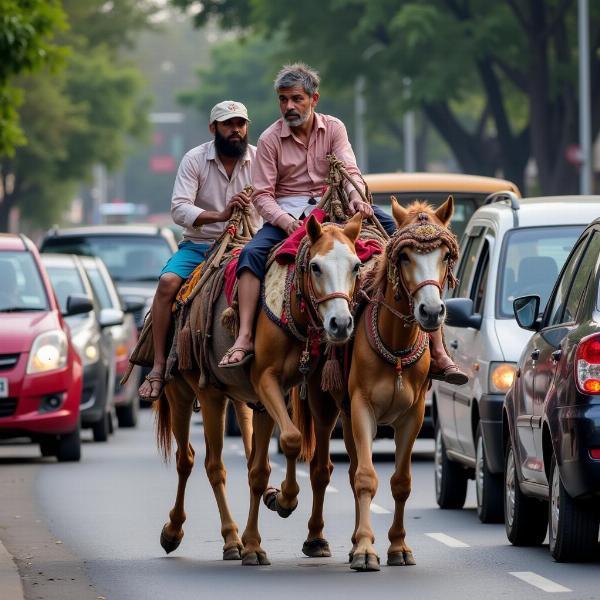Understanding the meaning of “tanga” in Hindi can be tricky, as it has multiple interpretations depending on the context. This guide will explore the various meanings of “tanga” in Hindi, delve into its cultural significance, and provide helpful examples to clarify its usage.
Exploring the Different Meanings of Tanga in Hindi
The word “tanga” can refer to several things in Hindi, often related to transportation or clothing. Let’s break down the most common meanings:
- Horse-drawn Carriage: This is perhaps the most traditional meaning of “tanga.” It refers to a two-wheeled carriage pulled by a horse, commonly used for transportation, especially in rural areas. Think of it as a charming, albeit slower, alternative to modern vehicles.
- Undergarment: In modern Hindi, “tanga” can also refer to a type of women’s undergarment, specifically a thong. This usage is more contemporary and might not be understood in all contexts.
- Trouble or Nuisance: In some regions, “tanga” can be used colloquially to describe a troublesome or annoying situation or person. This meaning is less formal and more context-dependent.
Cultural Significance of the Tanga
The horse-drawn tanga holds a special place in Indian culture, particularly in rural areas. It’s often associated with a slower pace of life, traditional values, and a connection to the past. While its use as a primary mode of transport has declined with modernization, the tanga remains a cultural symbol, often seen in festivals, weddings, and tourist attractions.
Tanga: Usage and Examples
To understand the different meanings of “tanga” in Hindi, let’s look at some examples:
- “Kal hum tanga mein bazaar gaye the.” (Yesterday, we went to the market in a tanga.) – This sentence clearly refers to the horse-drawn carriage.
- “Usne nayi tanga kharidi.” (She bought a new tanga.) – This sentence could refer to either the carriage or the undergarment, depending on the context.
- “Yeh bada tanga hai!” (This is a big tanga!) – In this context, “tanga” likely refers to a problem or nuisance.
Tanga vs. Tonga: A Common Confusion
Often, people confuse “tanga” with “tonga.” While both words refer to horse-drawn carriages, “tonga” is generally used in North India, while “tanga” is more common in other parts of the country.
What is the traditional use of a tanga?
Traditionally, tangas were used as a primary mode of transportation in rural India. They were a vital link between villages and towns, carrying people and goods.
Is the word “tanga” considered offensive?
While “tanga” itself isn’t inherently offensive, its meaning as an undergarment might be considered inappropriate to discuss in certain social settings. The colloquial meaning of “tanga” as a nuisance could also be perceived negatively. Context is key.
 Tanga in Modern Traffic
Tanga in Modern Traffic
Conclusion
Understanding the multiple meanings of “tanga” in Hindi requires considering the context of its usage. While the horse-drawn carriage remains its most recognizable meaning, awareness of its other interpretations is crucial for effective communication. Whether it’s a charming mode of transport, a piece of clothing, or a colloquialism for trouble, “tanga” continues to hold its own unique place in the Hindi language.
FAQs
- What is the difference between a tanga and a tonga? While both refer to horse-drawn carriages, “tonga” is commonly used in North India, while “tanga” is prevalent in other regions.
- Is “tanga” a formal word? While the meaning relating to the carriage is generally accepted, the other meanings are less formal and more context-dependent.
- How is “tanga” used in everyday conversations? It can refer to the carriage, an undergarment, or a nuisance, depending on the context.
- Where can I see a tanga today? Tangas can still be found in some rural areas, tourist spots, and during cultural events.
- Why is it important to understand the different meanings of “tanga”? Understanding the nuances of “tanga” helps avoid misunderstandings and ensures effective communication.
- What is the cultural significance of the tanga? The horse-drawn tanga represents a connection to India’s past, traditional values, and a slower pace of life.
- Is it appropriate to use “tanga” in all situations? Context matters. The meaning as an undergarment or a nuisance should be used with discretion.
Meaning-Hindi.in is your one-stop solution for all your Hindi translation needs. We offer a wide range of professional translation services, from business and legal documents to technical manuals and website localization. Our team of expert linguists ensures accurate and culturally sensitive translations. Contact us today for a free quote! Email: [email protected], Phone: +91 11-4502-7584. Meaning-Hindi.in also offers specialized services in technical, educational, and legal translation, ensuring precision and cultural sensitivity in every project.